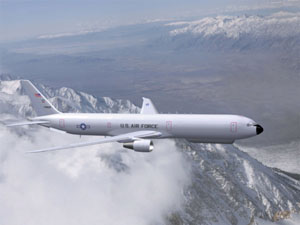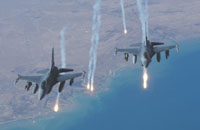Light and Radio Harmonized On One Channel
 |
| The goal of the Defense Advanced Research Projects Agency’s Optical and Radio Frequency Combined Link Experiment (ORCLE) is to combine laser and radio frequency communications into a reliable, variable bandwidth network. ORCLE is designed to support air-to-air and air-to-ground communications between platforms such as the E-10A airborne ground surveillance and battle management command and control aircraft and ground-based command centers. |
An experimental hybrid technology that combines both laser and radio frequency communications into a single system may soon provide warfighters with robust, high-bandwidth data networks. Software protocols will allow nodes in these networks to switch automatically between the two transmission modes based on the type of message sent and on prevailing atmospheric conditions.
Mobile networking is a vital part of the U.S. Defense Department’s future warfighting plans. However, these overarching information grids currently are incomplete and sometimes prone to failure. The weakest part of this structure is at the tactical level where passing data between individual aircraft or air and ground platforms can be compromised by bad weather. A reliable communications grid that connects mobile units in almost any circumstance would greatly enhance commanders’ situational awareness and help maintain operational tempo.
Managed by the U.S. Air Force Research Laboratory, Dayton, Ohio, and the Defense Advanced Research Projects Agency (DARPA), Arlington, Virginia, the Optical and Radio Frequency Combined Link Experiment (ORCLE) program will develop and test this dual technology for use in future airborne and air-to-ground communications networks. According to Stephen Griggs, ORCLE’s program manager, the technology is unique because it combines both radio frequency (RF) and laser communications in a single system.
To ensure network reliability, the program is developing software-based techniques such as clever networking and routing to make both technologies work to their strengths while mitigating their weaknesses. “Optical has a very high data rate, but its reliability in a mobile environment is iffy. RF on the other hand is very reliable, but the data rate is not quite there. By combining the two, we hope to make a better whole,” Griggs says.
ORCLE is a follow-on project of the Tera Hertz Operational Reachback (THOR) program. THOR explored the use of lasers to provide warfighters with a high-data-rate air-to-air and air-to-ground backbone. Although existing optical systems can transmit large amounts of data, they are more susceptible to environmental interference and therefore less reliable than RF-based communications. Griggs notes that optics can be used as point-to-point, high-data-rate links, but ORCLE has a much larger goal. “We are trying to make a network where these beams are pointing to different aircraft and ground targets. It’s by adding RF that we get sufficient network reliability to make it a reasonable thing to attempt,” he explains.
Reliability is especially important for air-to-ground links. While air-to-air communications are relatively free from interference, atmospheric phenomena can complicate transmissions to and from ground nodes. “If you want to operate in a wide range of environmental conditions, you must be able to deal with clouds, fog and sand storms, all of which are pretty bad for lasers,” Griggs explains.
Griggs emphasizes that the system does not simply switch a transmission from RF to laser. Depending on the size of a message and on prevailing atmospheric conditions, ORCLE will choose the most efficient method for sending it. “You use them both all the time. If you have a channel that just loves data rate, then you send that data optically. But at the same time, other data in the network are going to the RF side. If you’re in an optical message mode, you don’t want to turn around a 40-gigabit-per-second link for a 10-bit [RF] acknowledgment and reply,” he adds.
Combining the two techniques also greatly increases a communication network’s overall capability, says John Wojnar, director of advanced programs business development at Lockheed Martin’s Maritime Systems and Sensors division in Akron, Ohio. He maintains that ORCLE offers a thousand-fold increase in data rate over pure RF messaging, noting that DARPA and the Air Force wanted a link channel availability of at least 95 percent. Besides high reliability, program researchers also wanted to push data rates into the gigabit-per-second range, up from the current megabit-per-second rate. “They [DARPA] want to be able to increase data rates 1,000, maybe 10,000 times more than what exists right now,” Wojnar relates.
But achieving the program’s objectives requires technical advances in areas such as networking and laser beam steering applications. To make clever networking operate seamlessly, researchers are using existing protocols, such as Internet protocol, instead of developing new ones. But Wojnar notes that maintaining high data rates and avoiding latency remain major hurdles. “There are a lot of system challenges being undertaken by ORCLE that have never been done before,” he says.
Another network management challenge is prioritizing message traffic. In an ORCLE node, different types of signals will favor one kind of transmission method over the other, Griggs explains. However, if one of the transmission modes is lost, the platform-based nodes must know what to do. “How much data do I store? How long do I store it? What do I tell the person who sent me the data?” he asks.
 |
| ORCLE researchers are developing laser and radio frequency systems that will fit in small tactical aircraft such as F-16s. Because traditional gimbal-based systems are heavy and cause drag, the program is exploring technologies such as liquid crystal displays and microelectromechanical mirror systems that can conform to the skin of an aircraft. |
Because reliability is central to the program, ORCLE communication nodes will alert users about a transmission’s status. If a transmission failure should occur, each node can store 30 minutes of data at 10 gigabytes per second. But managing these nodes in a large ad hoc mobile network remains a challenge. “If I’ve got an optical link streaming data at 10 gigabits per second and an RF channel operating at 50 megabits per second, and I lose the optical channel for a little while, I’m now caching data at 10 gigabits per second someplace—because it’s not going on the RF channel. So you have to wonder which of the data that was going optical is important enough to go RF. The other stuff you store. What did you just store? How long do you store it? How long do you wait until you try to route it some other way?” Griggs observes.
Laser-based systems also present challenges. Because ORCLE nodes will be installed on a variety of airborne platforms such as fighter jets and unmanned aerial vehicles, researchers are developing systems that conform to the skin of an aircraft for weight and drag reduction. Wojnar notes that traditional gimbal-based laser aiming and reflecting devices, while adequate for large command and control aircraft, are heavy and create drag because they protrude into the air stream.
To address this issue, the program is examining technologies such as microelectromechanical mirrors—clusters of tiny mirrors that can be tilted and panned to reflect light. But he adds that they are currently very difficult to precisely control. Scientists also will examine the effects of turbulence and other atmospheric phenomena that occur around the skin of an aircraft. The goal of this research is to compensate for these effects while transmitting and receiving laser messages.
Other potential beam steering technologies under consideration include liquid crystal arrays and prisms. Prism-based systems have interesting features because they can be both reflective and refractive. “Since you are using a standard wavelength of only 1.55 microns, you can actually use prisms to deflect your laser beam. That helps reduce drag on any type of device that might protrude into the air stream,” he says.
As part of the program, DARPA also awarded a series of contracts to develop new technologies for the effort. This research explores applications such as a combined RF and electro-optical aperture for high-data-rate communications, transmissive liquid crystal optical phased arrays for laser transmissions, adaptive spectral encoding transceiver modems, and ultra short pulsed lasers and pulse shaping for optical wireless communications.
ORCLE was launched early this year with Lockheed Martin being awarded a $15 million contract as the system integrator. The program calls for testing to begin in the late summer or early fall of 2005. Based on the success of the environmental tests at White Sands, DARPA and the Air Force have the option to begin a 12-month flight test program using high-altitude aircraft.
As the chief systems integrator, Lockheed Martin will assemble all of the system’s different components at its Akron, Ohio, facility. There, it also will undergo a series of tests before being shipped to the White Sands missile range in New Mexico for more evaluation.
Web Resources
DARPA’s THOR/ORCLE Program: www.darpa.mil/ato/programs/orcle.htm
Lockheed Martin: www.lockheedmartin.com
U.S. Air Force Research Laboratory: www.afrl.af.mil




Comments